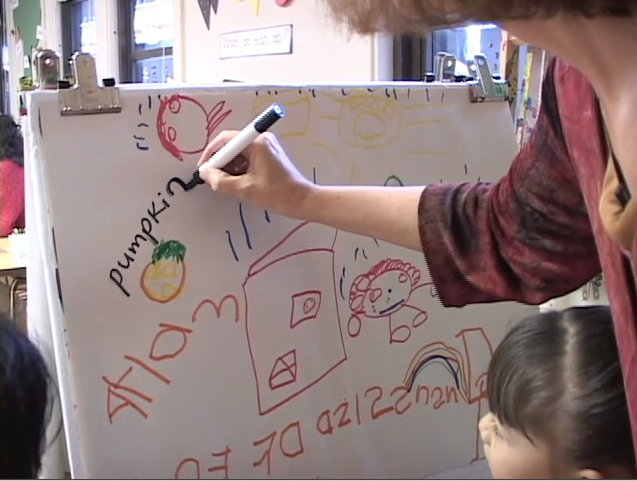Apr
15
Videatives Views Issue #207 Writing Words on a Child's Drawing
 Ariam seems pleased to share her new picture, hand-drawn family scenes that include many details. The teacher might think from these details that Ariam is ready to place print with her picture, and the teacher follows this lead by writing individual words for the child in a deliberate manner. This four-year-old child is demonstrating cognitive and linguistic strengths in her home langauge, Spanish, and the teacher knows that concepts learned in her first language will transfer to her secod language, English.
Ariam seems pleased to share her new picture, hand-drawn family scenes that include many details. The teacher might think from these details that Ariam is ready to place print with her picture, and the teacher follows this lead by writing individual words for the child in a deliberate manner. This four-year-old child is demonstrating cognitive and linguistic strengths in her home langauge, Spanish, and the teacher knows that concepts learned in her first language will transfer to her secod language, English.
Key to Ariam's future reading success, phonological awareness and concpets about print, are prominent processes explored in this snapshot. Ariam is learning about phonological awareness - the insight that we can manipulate the features of spoken words and the understanding that we combine sounds to make words. Listen to how the teacher pronunces, "pump - kin" and her lengthened breathe on the second syllable of "pa - pa'" as she writes the letters. Ariam is also learning concpets about print - the understanding of how print works: She is learning that print has a purpose and that print represents words that can be written down and can generate new thoughts. The teacher does more than just write down the words. She speaks with expressivity saying, "You can look out your window" as she writes the word. Hearing Ariam say "winder," the teacher pronounces "window" three times to model this new word for Ariam. When it comes time for the teacher to write "nombre" under the letters Ariam made, the teacher underlines these letters. Perhaps this is the teacher's way of helping Ariam keep in mind that letters are not pictures. In the fuller context of her program and home life, Araim will learn that books contain print from which we derive meaning.
In this quick glance, we also see the practice known as code switching - the ability or tendency to change langauges (codes). We notice that Ariam uses English for the words "pumpkin" and "window." Note that this is common practice when children are acquiring a new language. They use syllables, words or phrases from each of two langauges. Importantly, code switching does not indicate that children are confused. And, according to many who speak two or more languages, code switching can be fun!


